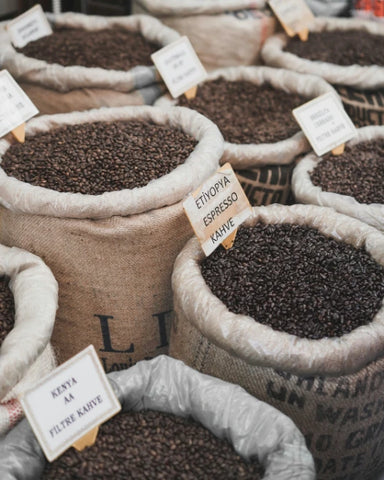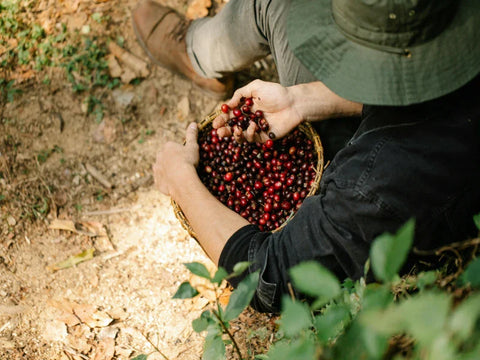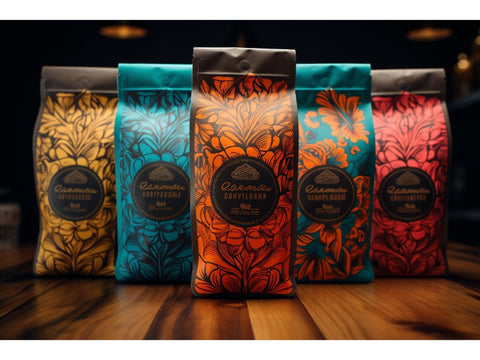Coffee beans are the seeds of the coffee plant, which are harvested and roasted to produce the popular beverage that is loved by millions around the world. But do you know where these beans come from and how they are grown? Follow along as we take you on a bean journey and discover the origins and process of coffee beans.
There are four main types of coffee beans, each with their own distinct characteristics and flavor profiles:
- Arabica Beans: Known for their smooth and mellow flavor, Arabica beans are the most popular and widely available type of coffee bean.
- Robusta Beans: These beans have a stronger and more bitter taste and are often used in blends or for making espresso.
- Liberica Beans: With a fruity and floral flavor, Liberica beans are a rare and unique type of coffee bean.
- Excelsa Beans: These beans have a tart and fruity flavor and are often used in blends to add complexity to the taste.
Coffee beans are primarily grown in three main regions: Africa and the Middle East, Asia and the Pacific, and Central and South America. Each region produces beans with unique characteristics and flavors.
Read: Bean Bonanza The Ultimate Guide to Understanding Coffee Beans
Growing coffee beans is a meticulous process that involves planting, cultivating, harvesting, and processing. The quality and flavor of the beans can be affected by various factors such as climate, soil, and processing and roasting methods.
Once the beans are harvested and processed, they are then roasted to bring out their distinct flavors and aromas. The roasting process can also affect the taste of the beans.
Coffee beans are sourced and traded through various methods such as direct trade, fair trade, and according to the guidelines set by the Specialty Coffee Association (SCA). These practices aim to ensure fair treatment of the farmers and sustainability of the industry.
Next time you enjoy a cup of coffee, take a moment to appreciate the journey that the beans have taken from their origin to your cup.
Key Takeaways:
What Are Coffee Beans?
Coffee beans are the seeds of the coffee plant, extracted from the coffee cherries after a process of drying and roasting. These beans come from various regions globally, including Ethiopia, Colombia, and Brazil. The two main types of coffee beans are Arabica and Robusta, each offering distinct flavors and caffeine levels. Arabica beans are known for their smooth taste and higher acidity, while Robusta beans have a bolder, more intense flavor with a higher caffeine content.
During my trip to Colombia, I had the opportunity to visit a coffee farm and witness the intricate process of harvesting and processing coffee beans. The aroma of freshly roasted beans permeated the air, creating an unforgettable sensory experience.
What Are the Different Types of Coffee Beans?

Coffee is a beloved beverage enjoyed by many around the world, but have you ever wondered where the beans that make your morning cup come from? In this section, we will delve into the world of coffee beans and explore the different types available. From the rich and flavorful Arabica beans to the bold and robust Robusta beans, we'll learn about the characteristics and origins of each type. We'll also take a look at the lesser known Liberica and Excelsa beans, and how they contribute to the diverse and complex flavors of coffee. So let's embark on a bean journey and discover the origins of our favorite caffeinated drink.
1. Arabica Beans
Arabica beans are cultivated through the following steps:
- Planting in optimal soil and climate conditions.
- Cultivating the plants to ensure healthy growth.
- Harvesting the ripe cherries by hand.
- Processing the cherries to extract the beans.
- Roasting the beans to develop their flavor.
Fact: Arabica beans are known for their smooth, aromatic characteristics.
2. Robusta Beans
Robusta beans, also known as Coffea canephora, are a type of coffee bean with a stronger and harsher taste compared to Arabica beans. These beans have nearly twice the amount of caffeine and are often used in espresso blends for their rich flavor and ability to produce crema.
3. Liberica Beans
Liberica beans, also known as Coffea liberica, are a type of coffee that originated in Liberia. These unique beans are known for their irregular shape, fruity and floral flavors, and woody overtones. Grown in countries like the Philippines and Malaysia, Liberica beans offer a distinct taste experience compared to Arabica or Robusta beans.
Pro-tip: For the best flavor, try a medium to dark roast when brewing Liberica beans.
4. Excelsa Beans
Excelsa beans, also known as Coffea excelsa or Coffea liberica var. dewevrei, are a unique and uncommon variety of coffee beans, accounting for only a small portion of the world's coffee production. These beans offer a distinctive flavor profile, featuring a complex and tart taste with hints of fruit and dark roast. They are primarily cultivated in Southeast Asia, specifically in areas such as the Philippines and certain parts of Malaysia.
Where Do Coffee Beans Come From?
Coffee is one of the world's most beloved beverages, but have you ever wondered where those delicious beans come from? In this section, we will take a journey through the origins of coffee beans and the regions that produce them. From the birthplace of coffee in Africa and the Middle East, to the diverse flavors of Asia and the Pacific, and finally to the rich and complex coffees of Central and South America, we will discover the fascinating story behind each cup of coffee we enjoy. So grab your favorite mug and let's begin our bean journey.
1. Africa and the Middle East
Coffee beans from Africa and the Middle East undergo a meticulous process to ensure quality:
- Harvesting: Skilled workers handpick ripe coffee cherries from the plants in these regions.
- Processing: The cherries are then processed using either the dry or wet method to remove the pulp and skin.
- Drying: The beans are spread out to dry, allowing them to develop their distinct flavor, unique to these regions.
- Transportation: Once dried, the beans are transported to various locations for roasting and packaging.
Pro-tip: For a rich and distinctive flavor, explore coffee beans sourced from Ethiopia or Yemen, two countries known for their exceptional coffee beans.
Read: Coffee Origins 101: Asia And Arabia
2. Asia and the Pacific
- The regions of Asia and the Pacific play a significant role in the production of coffee beans, contributing to the global coffee market.
- Countries such as Indonesia, Vietnam, and India are leading producers of coffee beans in Asia and the Pacific, each offering unique varieties of coffee beans.
- The coffee beans from this region are renowned for their distinct flavors, often influenced by the tropical climate and fertile soil.
For a diverse and unique coffee experience, consider trying coffee beans from Asia and the Pacific, which offer flavors such as earthy, spicy, and fruity notes.
Read: Coffee Origins 101: The Pacific
3. Central and South America
- Central and South America are known as major coffee-producing regions, including countries like Brazil, Colombia, Costa Rica, and Guatemala.
- Coffee cultivation in these regions involves various processes such as planting, tending, harvesting, and processing coffee cherries, which significantly contributes to the economy of the region.
- The flavor profile of coffee beans from Central and South America varies depending on factors such as altitude, climate, and soil composition.
Read: Coffee Origins 101: South America
What Is the Process of Growing Coffee Beans?

Have you ever wondered about the journey of coffee beans from plant to cup? In this section, we will delve into the intricate process of growing coffee beans and how they transform from a simple plant to the beloved beverage we know and love. From planting and cultivating to harvesting and processing, each step plays a crucial role in shaping the final product. We'll also explore the final step of roasting, where the beans reach their full flavor potential. So, let's dive into the world of coffee production and discover the fascinating journey of these little beans.
1. Planting and Cultivating
- Select an appropriate location with well-drained soil and partial shade.
- Prepare the soil by loosening it and incorporating organic matter to ensure optimal growth.
- Plant coffee seeds or seedlings at the start of the rainy season.
- Consistently maintain moisture and protect the plants from pests and diseases.
Pro-tip: Regularly prune the coffee plants to promote better fruit production and make harvesting easier.
2. Harvesting
Harvesting coffee beans involves several crucial steps:
- Selecting the right time to pick the cherries, ensuring they are ripe.
- Harvesting the cherries by hand to avoid unripe or overripe ones.
- Processing the cherries immediately to prevent spoilage and achieve optimal flavor.
- Drying the beans, either through sun-drying or mechanical drying methods.
When harvesting coffee beans, precision and care are essential to yield high-quality beans.
3. Processing
- Pulping: The outer skin is removed from the coffee cherry.
- Fermentation: The beans are soaked to break down the mucilage.
- Processing: The beans are sun-dried or mechanically dried to reduce moisture content.
- Grading and Sorting: Beans are sorted by size and weight to ensure uniformity.
- Roasting: The green coffee beans are roasted to develop their flavor and aroma.
4. Roasting
- Drying: The green coffee beans are dried to reduce moisture content, typically in the sun or using specialized dryers.
- Light roasting: Beans are heated until the first crack, producing a light roast with higher acidity and distinct origin flavors.
- Medium roasting: This stage involves heating the beans until the second crack, resulting in a balanced flavor profile.
- Beans are roasted beyond the second crack, leading to a bold, smoky flavor with lower acidity.
What Are the Factors That Affect the Flavor of Coffee Beans?

1. Climate and Soil
Factors such as climate and soil play a crucial role in determining the flavor and quality of coffee beans. Here's how:
- Climate: Coffee plants thrive in tropical regions with consistent temperatures and abundant rainfall.
- Soil: Well-drained, nutrient-rich soil is essential for the health of coffee plants and contributes to the flavor of the beans.
For optimal coffee cultivation, it is recommended to choose regions like Colombia or Ethiopia, which are known for their ideal climate and soil conditions.
2. Processing Method
-
- Wet Processing: Involves removing the fruit from the seeds before drying them.
-
- Processing Method: Dry Processing involves drying the cherries before separating the beans from the dried fruit.
-
- Honey Processing: The skin is removed, and the beans are dried with some or all of the sticky fruit pulp still clinging to them.
Did you know? The processing method significantly influences the flavor profile of coffee beans.
Read: Coffee Bean Processing: The Natural Method
3. Roasting Method
- Preheat the roaster: Begin by preheating the roaster to the recommended temperature, ensuring that it is ready for the beans.
- Add the beans: Carefully add the green coffee beans to the roaster, ensuring even distribution for consistent roasting.
- Monitor the process: Continuously monitor the beans, adjusting temperature and airflow as needed to achieve the desired roast level.
- Cool the beans: After roasting, promptly cool the beans to halt the roasting process and preserve flavor.
Fact: The roasting method significantly influences the flavor profile of coffee, with lighter roasts preserving more of the bean's unique characteristics.
How Are Coffee Beans Sourced and Traded?

1. Direct Trade
Direct trade is a method of purchasing coffee directly from farmers, promoting fair prices and fostering long-term relationships. The process includes:
- Visiting the farms to gain an understanding of their practices and establish trust.
- Negotiating prices and terms directly with the farmers.
- Setting quality standards and ensuring ethical practices are followed.
Pro-tip: Direct trade not only supports farmers, but also promotes transparency in the coffee supply chain, resulting in high-quality beans.
2. Fair Trade
- Ethical Practices: Fair trade ensures fair compensation and working conditions for coffee farmers.
- Community Support: It also provides support for community development projects, such as education and healthcare.
- Sustainability: Fair trade promotes environmentally sustainable practices, reducing the ecological impact of coffee production.
3. Specialty Coffee Association Guidelines
- Direct Trade: Emphasizes direct communication between coffee buyers and producers, ensuring fair pay and quality.
- Fair Trade: Focuses on ethical trading, guaranteeing fair prices and improved terms for farmers and workers.
- Specialty Coffee Association Guidelines: Set standards for specialty coffee, covering quality, sustainability, and trade practices.
Frequently Asked Questions
What is the history of coffee?

Coffee's exact origin is unknown, but there are many legends surrounding it. One legend tells of a goat herder named Kaldi in Ethiopia who discovered coffee after noticing his goats became energetic after eating the berries from a certain tree. Kaldi shared his findings with the abbot of a local monastery, who made a drink with the berries and found it kept him alert during evening prayer. The abbot shared the discovery with other monks and word of the energizing berries spread.
How did coffee cultivation and trade begin?
Coffee cultivation and trade began on the Arabian Peninsula, with Yemen being the first country to grow coffee in the 15th century. By the 16th century, coffee was known in Persia, Egypt, Syria, and Turkey. Coffee was not only consumed in homes, but also in public coffee houses called "qahveh khaneh" where people engaged in social activities like music, chess, and conversation. These coffee houses were known as "Schools of the Wise" due to their importance as centers of information exchange.
How did coffee spread to other parts of the world?
With thousands of pilgrims visiting Mecca each year, knowledge of coffee spread to other parts of the world. In the 17th century, coffee made its way to Europe and became popular across the continent. Some people were suspicious of this new beverage and called it the "bitter invention of Satan." The local clergy in Venice even condemned coffee, but Pope Clement VIII gave it papal approval after trying it himself.
What were coffee houses like in Europe?
Coffee houses became popular centers of social activity and communication in major European cities. In England, coffee houses were called "penny universities" because for the price of a penny, one could purchase a cup of coffee and engage in stimulating conversation. Coffee also began to replace traditional breakfast drinks like beer and wine. The popularity of coffee continued to grow, and by the 18th century, it had become one of the most consumed beverages in the world.
What is the coffee bean journey?
The coffee bean journey is a complicated process that involves many people and stages before it reaches the coffee consumer's cup. It starts with a teeny tiny seed being planted in a nursery in a sunny country. The seed grows into a healthy plant, which is then sent to a coffee plantation in countries like Brazil, Colombia, Honduras, and Nicaragua. It takes 3-4 years for a coffee plant to mature and produce harvestable beans.
What happens during the harvesting of coffee beans?
The beans start off as red cherries and are picked by plantation workers, as it is difficult to use machines in mountainous areas. Harvesting time is crucial for small farmers who rely on working with roasters to make money. After picking, the beans go through processing, drying, and milling to become raw coffee beans. From there, they go through the old fashioned method of roasting over hot water and animal fat until they turn into the medium brown roasted colour we are familiar with.


